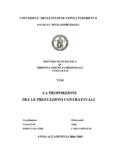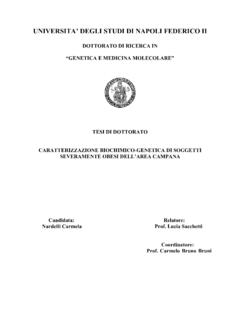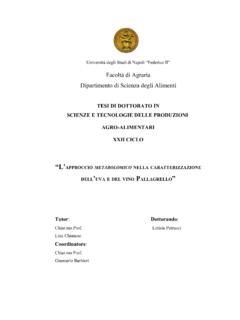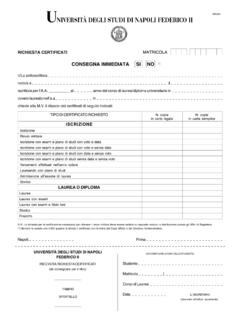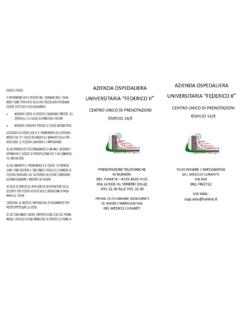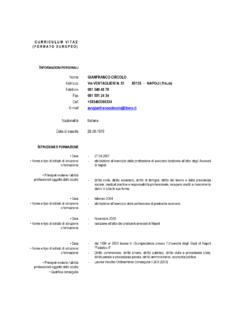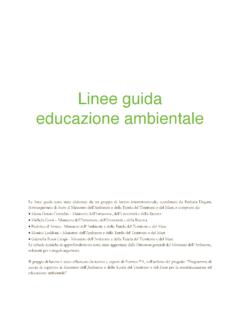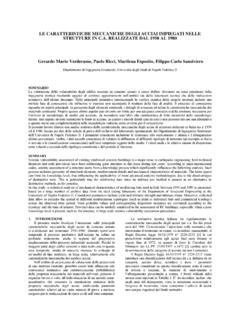Transcription of UNIVERSITA’ DI NAPOLI FEDERICO II - fedoa.unina.it
1 UNIVERSITA DI NAPOLI FEDERICO II DOTTORATO IN BIOCHIMICA E BIOLOGIA CELLULARE E MOLECOLARE Comunit Europea Fondo Sociale Europeo TESI DI DOTTORATO, 2007 REGOLAZIONE E MANIPOLAZIONE FARMACOLOGICA DEI SISTEMI ENDOVANILLOIDE ED ENDOCANNABINOIDE E POTENZIALI SVILUPPI TERAPEUTICI. DOTTORANDO: ANIELLO SCHIANO MORIELLO DIPARTIMENTO DI MEDICINA SPERIMENTALE DELLA SECONDA UNIVERSITA DI NAPOLI DOCENTE-GUIDA: Prof.
2 PASQUALE GRIPPO CORRELATORE: Dott. LUCIANO DE PETROCELLIS COORDINATORE: Prof. GIUSEPPE D ALESSIO Sommario Il sistema endocannabinoide formato dai recettori di membrana CB1 e CB2, (noti per la capacit di legare il principio attivo della Cannabis ?9-THC), dai loro ligandi endogeni (gli endocannabinoidi anandamide e 2-arachidonoil glicerolo) e dagli enzimi coinvolti nella biosintesi e degradazione degli endocannabinoidi.
3 Gli endocannabinoidi non sono conservati nelle cellule ma sono sintetizzati "on demand" e terminata la loro azione vengono rapidamente ricaptati ed idrolizzati. L anandamide anche un ligando endogeno del recettore dei vanilloidi TRPV1 (recettore di membrana attivato da temperature >42 C e dalla capsaicina il principio attivo dei peperoncini rossi che determina una sensazione di bruciore). Esiste una vasta letteratura sul coinvolgimento dei sistemi endocannabinoide ed endovanilloide in situazioni fisio-patologiche. Il mio progetto stato focalizzato: i) sullo studio dei meccanismi molecolari coinvolti nella trasduzione del segnale mediato dai sistemi endocannabinoide ed endovanilloide, ii) sulla modulazione di tale segnale mediante approccio farmacologico.
4 In particolare stata valutata la capacit da parte di nuovi composti di sintesi (derivati da due noti inibitori della ricaptazione cellulare dell anandamide, OMDM1 e OMDM2) di modulare mediante legame covalente con gruppi amminoacidici l ingresso nelle cellule di [14C] anandamide. Infatti, OMDM1-2 sono inibitori reversibili ed il loro effetto revertito mediante lavaggio delle cellule. Nel corso di questi studi sono stati identificati composti in grado di inibire stabilmente l'ingresso di [14C] anandamide nelle cellule. Tali studi rafforzano l'ipotesi della presenza di un trasporto facilitato dell'anandamide nelle cellule mediante un sistema di proteine specifiche (la cui esistenza al momento solo postulata).
5 Inoltre l individuazione di inibitori covalenti di tale processo potr essere utile per l identificazione delle proteine ivi coinvolte. Sono stati studiati nuovi antagonisti del TRPV1 quali l N-arachidonoil serotonina (gi noto per inibire l idrolisi dell anandamide) e due composti derivati dalla iodinazione in posizione 6 di olvanil e arvanil, noti agonisti del TRPV1. Per tale studio sono state utilizzate cellule HEK 293 trasfettate con TPRV1 valutando spettrofluorimetricamente la capacit del recettore di indurre ingresso di Ca2+. Inoltre stata studiata la regolazione del recettore TRPM8 (appartenente, come il TRPV1, alla famiglia di recettori TRP) e il suo cross-talk con il recettore CB1.
6 Il recettore TRPM8 attivato dalle basse temperature (<25 C) e dal mentolo che determina sensazioni di fresco. E' stato dimostrato che: i) l attivazione della proteina chinasi A determina una desensibilizzazione del TRPM8; ii) l anandamide stata identificata come primo antagonista endogeno del TRPM8. Per lo studio del cross-talk con il recettore CB1, cellule HEK 293 sono state co-trasfettate con i recettori TRPM8 e CB1. Da questi studi emerso che l'attivazione del CB1 modula negativamente il TRPM8. Infine stata dimostrata l attivit antiproliferativa di cannabinoidi vegetali su diverse linee cellulari tumorali ed il coinvolgimento dei sistemi endocannabinoide ed endovanilloide nell attivit di tali composti.
7 Abstract The endocannabinoid system consists of the cannabinoid receptors, (CB1 and CB2 known to bind the active component of Cannabis ?9-THC), their endogenus ligands (the endocannabinoids anandamide and 2-arachidonoyl glycerol), and the proteins responsible for the biosynthesis and inactivation of the ligands. The endocannabinoids are not stored in the cells but are biosynthesised on demand to be immediately released from the cells, then uptaked and hydrolysed. Anandamide is also an endogenus ligand of vanilloid receptor TRPV1, a membrane receptor activated by temperature > 42 C and by capsaicin the active principle of chilli peppers that elicits burning sensations.
8 There is a very large literature about involvement of endocannabinoid and endovanilloid system in an increasing number of physiological and pathological conditions. The aim of my project is focused on i) the study of molecular mechanisms involved in signal transduction of the endocannabinoid and endovanilloid system; ii) signal modulation by pharmacological approach. Particularly it has been evaluated the ability of new synthetic compounds (derived from two known inhibitors of anandamide uptake OMDM1 and OMDM2) to modulate the cellular uptake of [14C] anandamide by covalent bonds with aminoacid groups.
9 Indeed OMDM1 and OMDM2 are reversible inhibitors and their effect is reverted after washing the cells. In this study new compounds able to stably inhibit the cellular uptake of [14C] anandamide have been identified. These studies strengthen the hypothesis of the presence of a facilitated transport of anandamide by specific protein(s) (whose presence is at moment only postulated). Moreover the characterization of covalent inhibitors might permit to identify the proteins involved in this process. New antagonists of TRPV1 have been studied such as N-arachidonoyl serotonin (already known inhibitor of anandamide hydrolysis) and two compounds derived from the iodination on the 6 -carbon atom of olvanil and arvanil, known agonists of TRPV1.
10 HEK 293 cells transfected with TRPV1 have been used for this study, spectrofluorimetrically evaluating the capability of TRPV1 to induce Ca2+ influx. The regulation of TRPM8 receptor (a component of TRP receptor family as TRPV1) and the cross-talk mechanism with CB1 receptors have been studied. TRPM8 is a receptor responsive to cold (< 25 C) and to menthol that elicits cool sensations. It has been shown that i) protein kinase A activation down-regulates TRPM8 receptor; ii) anandamide has been identified as the first potential antagonist of TRPM8. The cross-talk study with CB1 receptors has been investigated in HEK 293 cells co-transfected with CB1 and TRPM8 receptors.
